Other uses
- Conversion of St. Paul Church (Vermont), a parish in Vermont
The Conversion of Paul the Apostle is an event in the life of Paul the Apostle.
The Conversion of Paul the Apostle, Saint Paul, Paul, or Saul may also refer to:

Michelangelo Merisida Caravaggio, known as Caravaggio, was an Italian painter active in Rome for most of his artistic life. During the final four years of his life he moved between Naples, Malta, and Sicily until his death. His paintings have been characterized by art critics as combining a realistic observation of the human state, both physical and emotional, with a dramatic use of lighting, which had a formative influence on Baroque painting.

Baroque painting is the painting associated with the Baroque cultural movement. The movement is often identified with Absolutism, the Counter Reformation and Catholic Revival, but the existence of important Baroque art and architecture in non-absolutist and Protestant states throughout Western Europe underscores its widespread popularity.
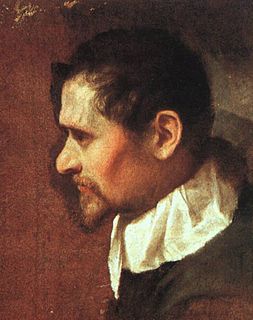
Annibale Carracci was an Italian painter and instructor, active in Bologna and later in Rome. Along with his brother and cousin, Annibale was one of the progenitors, if not founders of a leading strand of the Baroque style, borrowing from styles from both north and south of their native city, and aspiring for a return to classical monumentality, but adding a more vital dynamism. Painters working under Annibale at the gallery of the Palazzo Farnese would be highly influential in Roman painting for decades.

Dirck Jaspersz. van Baburen was a Dutch painter and one of the Utrecht Caravaggisti.
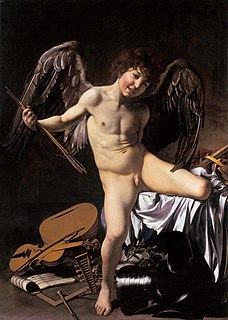
Amor Vincit Omnia is a painting by the Italian Baroque artist Caravaggio.

The Conversion on the Way to Damascus is a work by Caravaggio, painted in 1601 for the Cerasi Chapel of the church of Santa Maria del Popolo, in Rome. Across the chapel is a second Caravaggio depicting the Crucifixion of Saint Peter. On the altar between the two is the Assumption of the Virgin Mary by Annibale Carracci.

The Crucifixion of Saint Peter is a work by Michelangelo Merisi da Caravaggio, painted in 1601 for the Cerasi Chapel of Santa Maria del Popolo in Rome. Across the chapel is a second Caravaggio work depicting the Conversion of Saint Paul on the Road to Damascus (1601). On the altar between the two is the Assumption of the Virgin Mary by Annibale Carracci.

The Calling of Saint Matthew is a masterpiece by Michelangelo Merisi da Caravaggio, depicting the moment at which Jesus Christ inspires Matthew to follow him. It was completed in 1599–1600 for the Contarelli Chapel in the church of the French congregation, San Luigi dei Francesi in Rome, where it remains. It hangs alongside two other paintings of Matthew by Caravaggio, The Martyrdom of Saint Matthew and The Inspiration of Saint Matthew (1602).

The Martyrdom of Saint Matthew is a painting by the Italian master Michelangelo Merisi da Caravaggio. It is located in the Contarelli Chapel of the church of the French congregation San Luigi dei Francesi in Rome, where it hangs opposite The Calling of Saint Matthew and beside the altarpiece The Inspiration of Saint Matthew, both by Caravaggio. It was the first of the three to be installed in the chapel, in July 1600.

Caravaggio created one of his most admired altarpieces, The Entombment of Christ, in 1603–1604 for the second chapel on the right in Santa Maria in Vallicella, a church built for the Oratory of Saint Philip Neri. A copy of the painting is now in the chapel, and the original is in the Vatican Pinacoteca. The painting has been copied by artists as diverse as Rubens, Fragonard, Géricault and Cézanne.
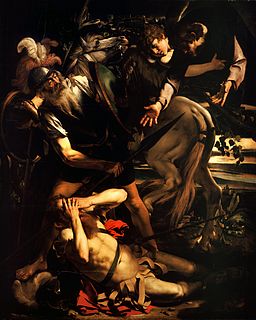
The Conversion of Saint Paul, by the Italian painter Caravaggio, is housed in the Odescalchi Balbi Collection of Rome. It is one of at least two paintings by Caravaggio of the same subject, the Conversion of Paul. Another is The Conversion of Saint Paul on the Road to Damascus, in the Cerasi Chapel of Santa Maria del Popolo.
John the Baptist was the subject of at least eight paintings by the Italian Baroque artist Michelangelo Merisi da Caravaggio (1571–1610).

The Cerasi Chapel or Chapel of the Assumption is one of the side chapels in the left transept of the Basilica of Santa Maria del Popolo in Rome. It contains significant paintings by Michelangelo Merisi da Caravaggio and Annibale Carracci, two of the most important masters of Italian Baroque art, dating from 1600-1601.

The Cappella Paolina is a chapel in the Apostolic Palace, Vatican City. It is separated from the Sistine Chapel by the Sala Regia. It is not on any of the regular tourist itineraries.
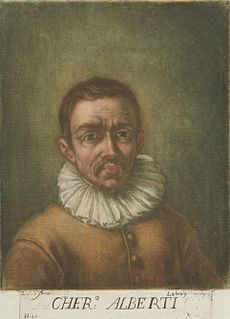
Cherubino Alberti (1553–1615), also called Borghegiano, was an Italian engraver and painter. He is most often remembered for the Roman frescoes completed with his brother Giovanni Alberti during the papacy of Clement VIII. He was most prolific as an engraver of copper plates.

The conversion of Paul the Apostle was, according to the New Testament, an event in the life of Saul/Paul the Apostle that led him to cease persecuting early Christians and to become a follower of Jesus. It is normally dated to AD 34–37 which is 4-7 years after Jesus' Crucifixion on Friday April 7, 30 AD.
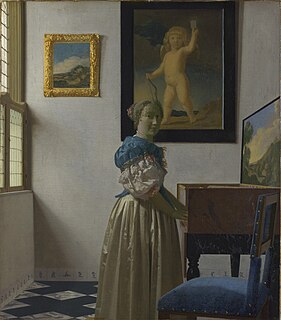
The National Gallery is the primary British national public art gallery, sited on Trafalgar Square, in central London. It is home to one of the world's greatest collections of Western European paintings. Founded in 1824, from an initial purchase of 36 paintings by the British Government, its collections have since grown to about 2,300 paintings by roughly 750 artists dating from the mid-13th century to 1900, most of which are on display. This page lists some of the highlights of the collection.

Italian Baroque art is a term that is used here to refer to Italian painting and sculpture in the Baroque manner executed over a period that extended from the late sixteenth to the mid eighteenth centuries.

The Conversion of St. Paul is a 1614 painting by Juan Bautista Maíno, located in the collection of the National Museum of Art of Catalonia (MNAC).

The Assumption of the Virgin by Annibale Carracci is the altarpiece of the famous Cerasi Chapel in the church of Santa Maria del Popolo in Rome. The large panel painting was created in 1600–1601. The artwork is somewhat overshadowed by the two more famous paintings of Caravaggio on the side walls of the chapel: The Conversion of Saint Paul on the Road to Damascus and The Crucifixion of Saint Peter. Both painters were important in the development of Baroque art but the contrast is striking: Carracci's Virgin glows with even light and radiates harmony, while the paintings of Caravaggio are dramatically lit and foreshortened.